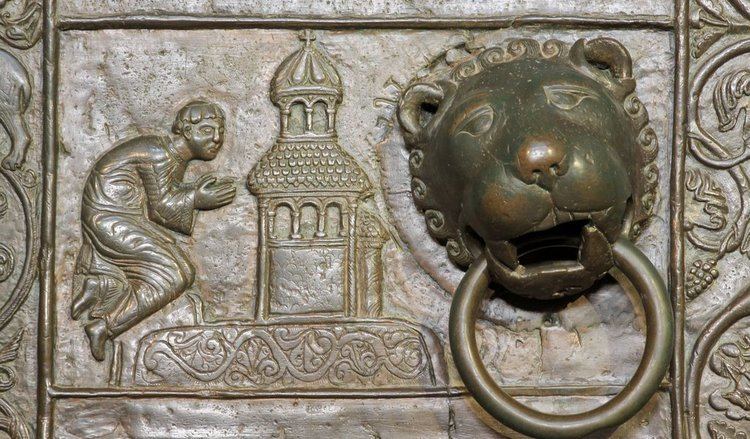 | ||
Similar Pomnik Bolesława Chrobrego, Porte de Korsoun, Veit Stoss altarpiece in Kraków, Beautiful Virgin Mary from Kruż, Bernward Doors | ||
The Gniezno Doors (Polish: Drzwi Gnieźnieńskie) are a pair of bronze doors at the entrance to Gniezno Cathedral in Gniezno, Poland, a Gothic building which the doors pre-date, having been carried over from an earlier building. They are decorated with eighteen scenes in bas-relief from the life of St. Adalbert, or Wojciech in Polish, whose remains had been bought for their weight in gold (shown in scene 16), and carried back to the cathedral and set up in a shrine there. They were made in about 1175 during the reign of Mieszko III the Old and are one of the most significant works of Romanesque art in Poland.
Contents

Placing the origin of the doors
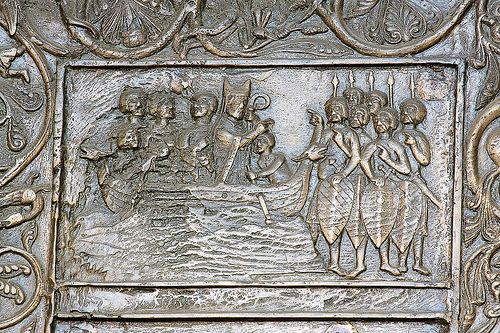
Locating the origin of the doors has been the subject of much discussion. It is clear that their style derives from the Mosan area in modern Belgium and France. Their place of manufacture has been argued to be Hildesheim (home of the famous Bernward Doors of about 1015), Bohemia, Flanders (perhaps Liege), or locally. Swartzenski says "design and wax model, Liege (?)" but "cast in Gniezno (?)", "soon after 1127", but this date now seems very much a minority view - it was the year when St Adalbert's head was "recovered", not having been with the initial batch of relics. Another possibility is that the artists and craftsmen were imported from further West for the commission, perhaps easier than transporting the single piece of the left door, either in wax or bronze form, across much of Europe. At this time the Polish church had strong links with the Archdiocese of Cologne and the home area of Mosan art, which led Western European metalwork at this date. The question has not been settled by the discovery during restoration work in 1956 of partly effaced inscriptions reading "me fecit me...us", "petrus" and "bovo luitinius/latinus", probably giving the name of the craftsman in charge of the casting. These mean "made by" ... "Peter" ..." of ? [place]", with the "luitinius" location probably referring either one the four Lutins in modern Poland (not all possible candidates at this date), or Lille in northern France not far from the Mosan region, or Lucino near Como in northern Italy. If the reading is "latinus", or "Peter the Latin made me", the meaning is even less clear, but this is regarded as the less likely reading. Neither name is known in any other contexts.
Description
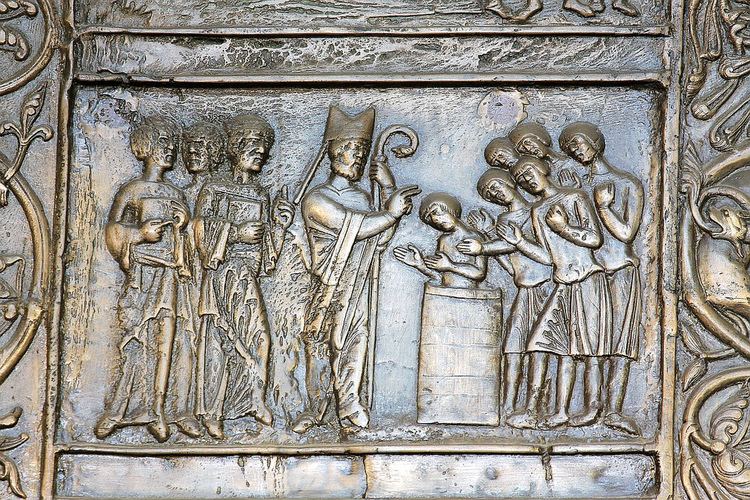
The left door (facing the reliefs from outside the cathedral) is 328 cm high and 84 cm wide, the right 323 cm high and 83 cm wide. Both are between 1.5 and 2.5 cm thick. They were cast in bronze using the lost wax casting technique in a mixture of copper, tin with a small amount of lead, with some fine detail being added after casting by engraving tools. The left leaf was cast in one piece, but the right was made in 24 cast sections which were then soldered together. Both the lion-headed knockers, which do not align correctly, were also cast separately and soldered. The doors of Hildesheim Cathedral, of about 1015, had pioneered the casting of a large door mostly covered with reliefs in a single piece, which was considerably more difficult than the usual technique of earlier Italian bronze doors, which used bronze relief casts fixed to a wooden core. Plain doors with no figurative decoration had already been cast whole in Germany - for example for Charlemagne's early 9th century Palatine Chapel at Aachen, following Roman techniques preserved by the Byzantines. The Gniezo left door follows the Hildesheim method. The relief is also typically much higher on the left door, as much as 75% on some figures, where few on the right door reach 25%. Around the central panels runs a decorative frieze of Mosan-style "rinceaux", or scrolling foliage, with small figures of astrological personifications and other subjects at intervals.
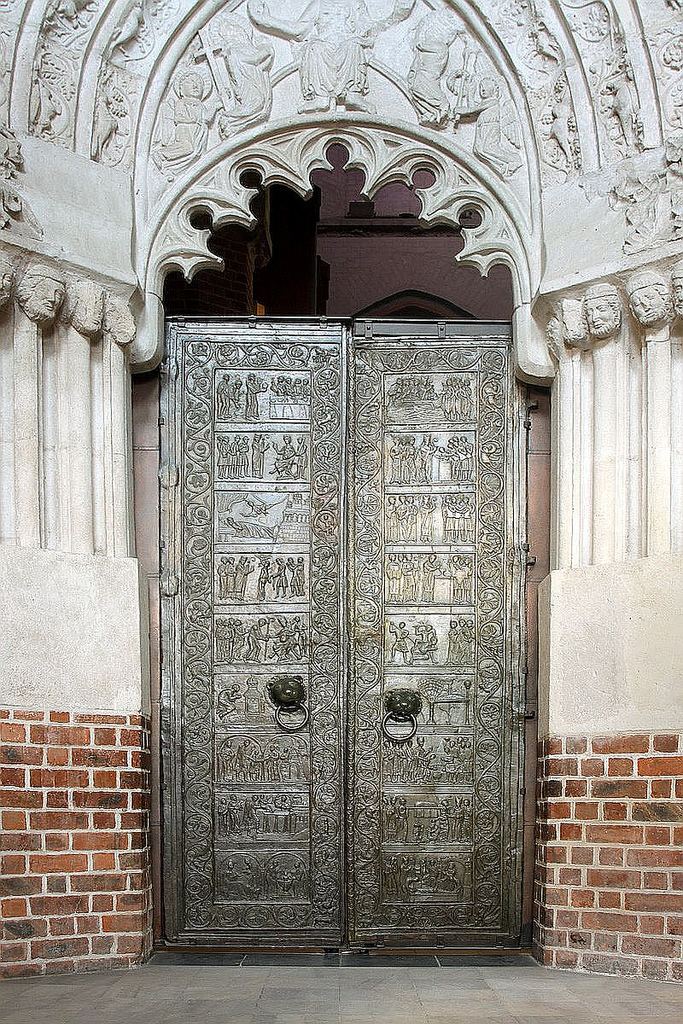
Adalbert had been martyred trying to convert the pagan Prussians, who are shown in some scenes, giving a rare near-contemporary record of their appearance; the Prussians remained largely pagan at the time the doors were made. To illustrate the life of a single saint on such a monumental scale was most unusual at this period, and the doors are the only Romanesque ones in Europe with such a programme. The designs perhaps followed a now lost cycle in an illuminated manuscript of the life of the saint, though even in this sort of works such an extended pictorial treatment of a saint's life was unusual. Two lives of Adalbert have survived, written around 1000, soon after his death, but no illuminated copies that throw light on the visual sources for the doors, though their texts help explain the scenes. Whatever the origin of the designs, the compositions show the borrowings from more common subject compositions to which early medieval artists usually resorted when confronted with a novel subject; devising new compositions was not part of their training. Some scenes adapt subjects from the Life of Christ and other models. The left door shows his early life and life in Christian territory; the right one his missionary activities, apparently ignoring those outside modern Poland. Their iconography "clearly shows they were made as a political statement".
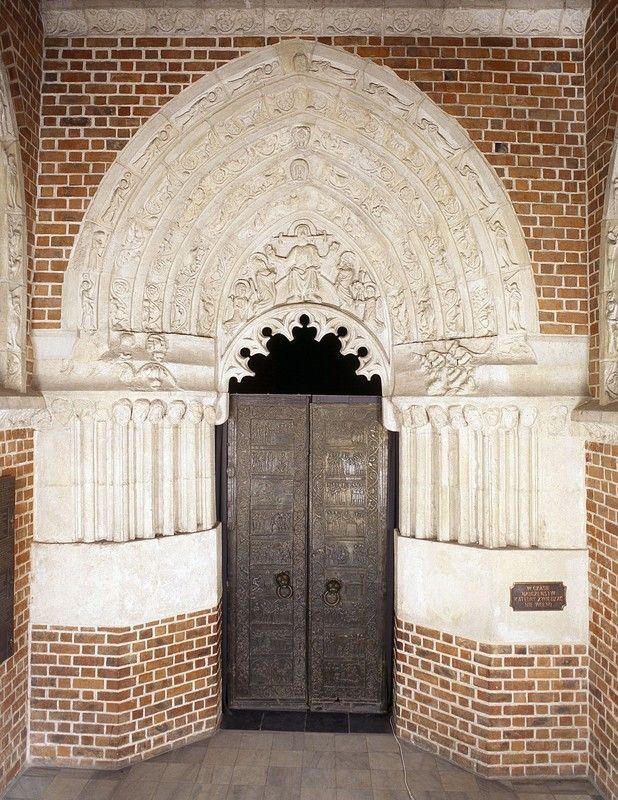
The only comparable bronze doors in Poland were those made in Magdeburg in about 1150 for Plock Cathedral, using a much less advanced style and technique; however these were carried off during the Middle Ages by a Russian army, and installed in Saint Sophia Cathedral in Novgorod, where they remain. Plock now has 20th century replicas in place.
Subjects of the panels

The sequence starts from the bottom of the left door, going upwards, then to the right door going down. Adalbert ("he") is the centre of all scenes.
1) His birth and baptism, in two scenes2) As a sick child he is saved by being placed on an altar dedicated to the Virgin Mary3) His parents place him in the monastery at Magdeburg at his request4) He prays before a shrine (with knocker)5) Emperor Otto II gives him his bishop's crozier, which happened at Verona6) He expels a demon from a possessed man7) He has a vision of Christ telling him to save Christians from slavery by the Jewish traders8) He pleads with the Duke of Bohemia for the release of Christians slaves by their Jewish masters9) The accident of the wine pitcher - when he dropped one it did not break10) He lands in Gdańsk by ship (top of right door)11) He makes conversions there12) He preaches13) He says Mass on the morning of his death, with hostile Prussians on the right14) He is martyred by two men, while his companions watch15) His body is exposed in the open, with his severed head on a stake; an eagle guards it (with knocker)16) His remains are bought by the Polish ruler from the Prussians, for their weight in gold17) His remains are taken back to Gniezno18) His remains are buried in Gniezno Cathedral (bottom of right door)